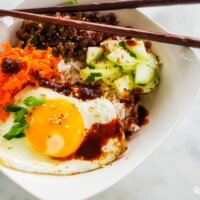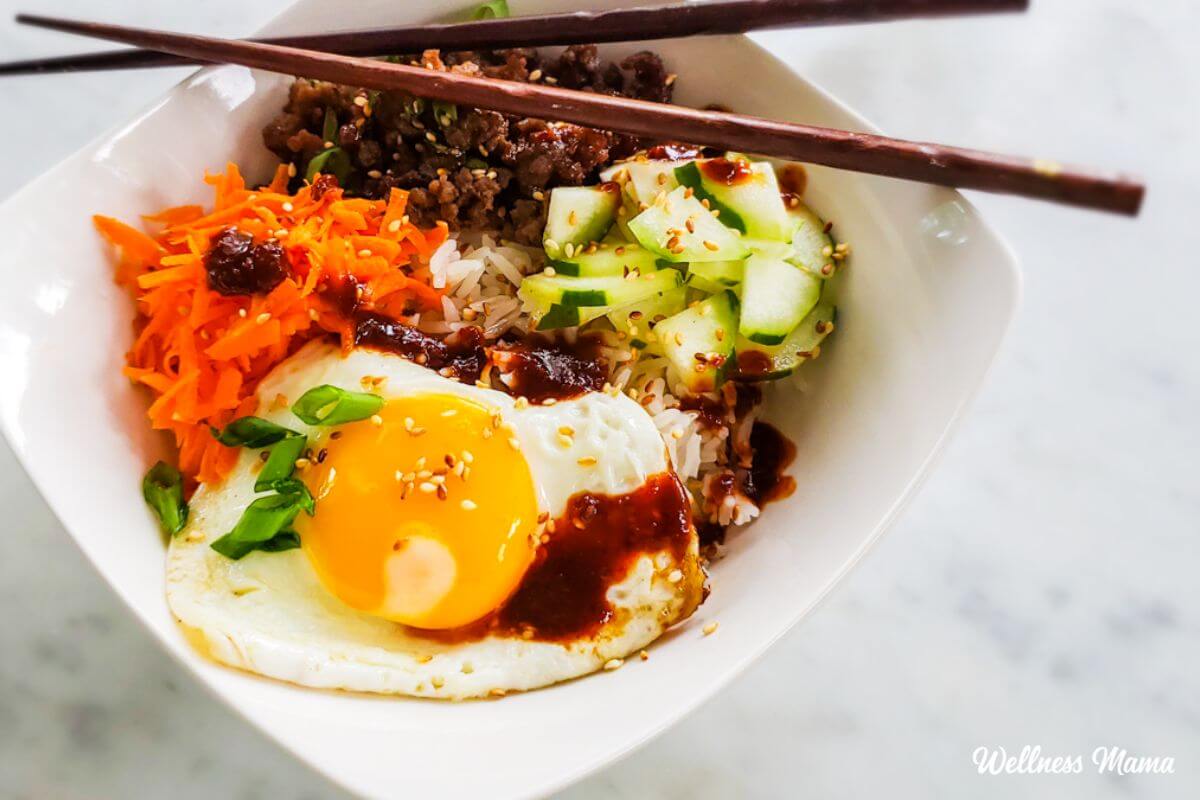I’ve gradually rolled out some Korean recipes over the past year. Up till now, my kids had voted Korean chicken wings as their favorite Korean food recipe I’d made. Then I made a Korean rice bowl (bibimbap) and they had a new favorite.
This dish has gained a lot of popularity in recent years and is really easy to make, even on busy weeknights. You can reheat rice for an even faster recipe and tweak it to your preferences. We really like this naturally gluten-free Asian meal, and I hope you will too.
What is Bibimbap?
Bibimbap is a Korean rice bowl with colorful veggies, meat, a fried egg, and sauce. It’s meant to be all mixed together before eating and can be as simple or complicated as you want to make it. I tend to lean toward easier, raw veggie toppings, just because life is so busy! But on nights we have more time, I’ll put a little more effort into it.
You can also make a stir-fry Korean beef bowl with cooked veggies, like broccoli and bell peppers, and saute some onion in there too. Either way, the rice bowls always turn out delicious.
On really busy days I like to meal prep ahead of time and reheat the dishes for later. These Korean ground beef and rice bowls really reheat well!
Here are the key elements of good bibimbap:
Make the Sauce
A good rice bowl really needs a good sauce. You can leave it off, but it’s just not the same. I use gochujang for the sauce base and you can find my recipe here. I use it so often that I keep a batch of it in my fridge because I use it in so many Korean recipes.
To the gochujang, I add some coconut aminos (instead of regular soy sauce or low sodium soy sauce), honey, garlic powder, and sesame oil. You can also substitute some minced garlic for the powder if that’s what you have on hand. The sauce is delicious and works perfectly for bibimbap. It’s also really good drizzled over fish tacos!
Get the Rice Cooking
Just cook whatever rice your family normally uses. Jasmine rice is my favorite because it has lower arsenic levels than other kinds and it’s delicious. Regular white rice or brown rice would also work, but you can read more on my thoughts about healthy rice here.
Need a low-carb option? Cauliflower rice is your friend.
While the rice is cooking you’re going to be cooking the meat, preparing the vegetables, and making the sauce. If the rice finishes cooking before you’re done with the other preparations, it’s completely fine. Just turn off the heat and leave the lid on so the rice stays warm. You can also reheat leftover rice if you have some in the fridge.
Cook the Meat
I cook the meat in a large skillet, drain it, and then add the chili garlic sauce, coconut aminos, and maple syrup. Ground turkey would also work if you like, but I prefer the flavor of the beef. Some bibimbap recipes call for a marinade on the meat, but that takes more time and there’s still plenty of flavor this way.
Get the Vegetables Ready
You can use whatever combination of fresh, sauteed, or pickled vegetables you like. For ease and simplicity, I usually use my food processor to grate carrots and slice cucumbers. I sometimes add kimchi or fermented veggies as well if I have it on hand. I’ve included a list of other vegetables below if you’d like some more ideas.
Fry the Eggs
Fried eggs are nearly always included on top of Korean rice bowls. The runny, sunnyside-up yolk is mixed into the rest of the bowl for a rich, creamy texture. I use a large skillet and fry several at a time.
Assemble the Bowls
Assemble the bowls by scooping rice into a bowl. Top with the ground beef, prepared vegetables, a fried egg, a sprinkle of green onion and sesame seeds, and a drizzle of sauce. Mix it all together and enjoy!
For some extra spice, you can garnish it with some red pepper flakes or a little sriracha. Bean sprouts or a little fresh or ground ginger are also a nice addition. There are really so many options here!
Korean Rice Bowl Recipe Variations
Rice bowls are a perfect recipe to customize. You can modify pretty much every single component to fit your preferences and still have a delicious meal.
- Rice – We need some element of rice to have a rice bowl, but you can absolutely use cauliflower rice instead of regular rice.
- Meat – I use ground beef, but chopped steak, ground turkey, or even diced chicken will work. Or leave it out altogether. And if you don’t like a lot of heat, you can leave out the chili garlic sauce and use a little garlic powder and sesame oil instead.
- Vegetables – There are so many options! Here are a few: sauteed carrots, zucchini, mushrooms, onions, or spinach.
- Sauce – Easily modify the heat of the sauce recipe by using more or less gochujang and more or less coconut aminos and honey. Or use straight coconut aminos mixed with garlic powder, sesame oil, and a little honey.
- Garnish – I mostly use raw vegetables, but here are some more options to top off the rice bowls: Sprouts, kimchi, pickled Korean radishes, and seasoned seaweed.
Whatever combination of ingredients you choose, I hope your family enjoys it as much as mine!

Bibimbap (Korean Rice Bowl) Recipe
Servings
Equipment
Ingredients
Chili Garlic Sauce Ingredients
- ¼ cup gochujang paste
- 2 TBSP coconut aminos (or tamari)
- 2 TBSP rice vinegar (or apple cider vinegar)
- 2 TBSP water
- 2 TBSP honey
- 2 tsp sesame oil
- ½ tsp garlic powder
- 2 tsp sesame seeds
Rice Bowl Ingredients
- 8 cups cooked rice (or cauliflower rice)
- 2 lbs ground beef
- 2 TBSP chili garlic sauce
- ¼ cup coconut aminos (or tamari)
- ¼ cup maple syrup (or 2 TBSP brown sugar)
- 3 carrots (grated)
- 2 cucumbers (very thinly sliced)
- 3 green onions (sliced)
- 8 eggs
- 2 TBSP sesame oil
- 2 TBSP sesame seeds
Instructions
Make the Chili Garlic Sauce:
- In a small bowl, whisk together all the ingredients for the sauce.
- Set aside.
Prepare the Rice Bowls:
- Cook or reheat the rice or cauliflower rice.
- While the rice is cooking, brown the ground beef over medium-high heat, draining the fat off once cooked.
- Stir the chili garlic sauce, coconut aminos, and maple syrup into the beef mixture.
- Cook for about 5 minutes to allow the flavors to blend.
- In a seperate skillet, fry the eggs sunny-side-up in sesame oil, leaving the center mostly soft. Work in batches if necessary.
Assemble the Bowls:
- Scoop about 1 cup of rice into a bowl.
- Top with ground beef, shredded carrots, sliced cucumbers, green onion, and sesame seeds.
- Gently place an egg on top.
- Drizzle with the chili garlic sauce.
Nutrition
Notes
- If you don’t want spicy meat and sauce you can either leave off the sauce or use a little maple syrup, garlic powder, coconut aminos, and sesame oil in the ground beef.
- These bibimbap bowls are also great reheated. I assemble leftovers into ready-to-eat bowls and refrigerate them for future meals.
How did your Korean rice bowl turn out? I’d love to hear about your experiences!


Leave a Reply